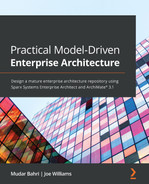Table of Contents
Preface
Section 1: Enterprise Architecture with Sparx Enterprise Architect
Chapter 1: Enterprise Architecture and Its Practicality
Understanding TOGAF®
TOGAF® implementation benefits
TOGAF® implementation drawbacks
Introducing agile EA
Understanding agile EA?
Comparing agile EA with EA
Embedding agile EA into TOGAF®
Introducing ArchiMate®
ArchiMate®'s role in EA artifacts
Understanding ArchiMate® modeling specification
Metamodels
Introducing our focused metamodels
Introducing Sparx Systems Enterprise Architect
Why Sparx?
The Sparx UI
Summary
Chapter 2: Introducing the Practice Scenarios
Structuring the book around the scenarios
A brief on ABC Trading
The structure of the book
First scenario – application architecture
Scenario description
Artifacts backlog
Second scenario – technology architecture
Scenario description
Artifacts backlog
Third scenario – business architecture
Scenario description
Artifacts backlog
Summary
Section 2: Building the Enterprise Architecture Repository
Chapter 3: Kick-Starting Your Enterprise Architecture Repository
Technical requirements
Building the application component context diagram
Establishing your first diagram
Creating the repository file
Creating the diagram
Describing the diagram
Changing the diagram theme
Adding elements to the diagram
Starting with the application component
Introducing application services
Adding Actors
Identifying other dependent elements
Summary
Chapter 4: Maintaining Quality and Consistency in the Repository
Technical requirements
Building the application component focused metamodel
Establishing the metamodel diagram
Interpreting an ArchiMate® metamodel
Adding elements from other architecture layers
Modeling best practices
Keeping your diagram focused
Fitting your diagram onto a single page
Adding only the necessary information
Paying attention to your diagram's appearance
Knowing your audience
Summary
Chapter 5: Advanced Application Architecture Modeling
Technical requirements
Determining what diagrams to produce
Understanding the view
Structural and behavioral views
Getting to know the viewpoint
Describing application behavior
Introducing application services
Introducing application processes
Introducing application functions
Introducing application interactions
Introducing application events
Describing application structure
Revisiting the application component
Introducing application interfaces
Introducing application collaborations
Introducing data objects
Summary
Chapter 6: Modeling in the Technology Layer
Technical requirements
Modeling technology environments
Examples of technology models
Diagram filters and layers
Technology stacks
Interpreting the standard
Using the node element
Using the device element
Using the system software element
Using the technology interface element
Using the technology collaboration element
Using the technology artifact element
Modeling physical environments
Understanding the equipment element
Understanding the facility element
Understanding the distribution network element
Understanding the material element
Understanding the location element
Putting the elements together for ABC Trading
Modeling dependencies in ArchiMate® 3.1
Modeling networks
The communication network element
Communication network-focused metamodel
The path element
Path element-focused metamodel
Summary
Chapter 7: Enterprise-Level Technology Architecture Models
Technical requirements
Using technology behavioral elements
Using the Technology Service element
Using the Technology Function element
Using the technology process
Using the technology interaction element
Using the Technology Event element
ABC Trading's technology background
Building the technology components catalog
Defining the technology components catalog
Collecting the information
Formatting the CSV file
Importing the CSV file into Sparx
Equipment and system software
Modeling technology services
Identifying existing services
Mapping services to technology components
Using the matrix feature
Reporting our findings
The diagram option
The report option
Summary
Chapter 8: Business Architecture Models
Technical requirements
Modeling the business structure
Defining business actors
Defining business roles
Defining business collaboration
Defining business interfaces
Defining business objects
Modeling business behavior
Defining business services
Defining business processes
Defining business functions
Defining business interactions
Defining business events
Summary
Chapter 9: Modeling Strategy and Implementation
Technical requirements
Introducing strategy elements
Defining capabilities
Value streams
Defining resources
Courses of action
Modeling the ABC Trading strategy
Introducing implementation elements
Defining plateaus
Defining gaps
Defining work packages
Defining deliverables
Defining implementation events
Summary
Section 3: Managing the Repository
Chapter 10: Operating the EA Repository
Technical requirements
Sharing repositories
Organizing and reorganizing the repository
Model abstraction
Model replication
Version management
Sandboxes
Element status
Managing the shared repository
Configuration management
Implementing security
Model locks
Deleting and merging elements
Backup and restore
Automation
Repository governance
Architecture governance
Repository governance
Summary
Chapter 11: Publishing Model Content
Technical requirements
Generating document reports
Introducing report templates
Future-proofing your templates
Template fragments
Including diagrams in your report
Document options
Excluding packages and diagrams from a document
Creating more complex documents
Generating HTML content
Using charts
Creating custom SQL queries
The copy-and-paste approach
Summary
Other Books You May Enjoy
..................Content has been hidden....................
You can't read the all page of ebook, please click here login for view all page.
